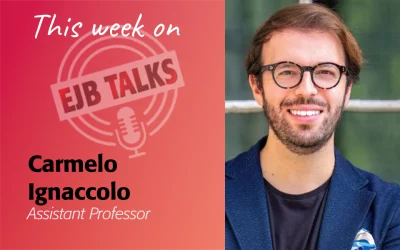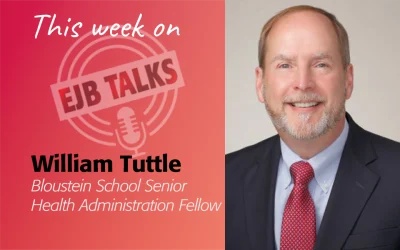Stuart Shapiro welcomes Assistant Professor Kelcie Ralph from Bloustein’s highly ranked Urban Planning Program to this week’s EJB Talks to discuss her research on pedestrian and bike safety. Professor Ralph reveals that her personal experience traveling–sans automobile–made her determined to focus on safety in her research. She discusses how the use of certain language, and the shift to victim-blaming by the media when reporting crashes, changes the dynamic from a public health issue to a personal issue. Professor Ralph also explains the origins of the language the media uses in reporting bike/ped accidents, how simple but changeable safety aspects such as speed limits are developed, and how some localities have made positive policy changes to improve safety.
Stuart Shapiro
Welcome to EJB Talks. I am Stuart Shapiro, the Associate Dean of Faculty at the Bloustein School, and the purpose of this podcast is to talk with my colleagues and our alumni about policy, planning, and health, the interaction between these issues, and how they affect people in New Jersey, the United States, and the world.
Today, we’re really happy to have Professor Kelcie Ralph, who teaches transportation planning in our nationally ranked urban planning program. Welcome to the podcast, Kelcie.
Kelcie Ralph
Thanks for having me.
Stuart Shapiro
So how did you become interested in pedestrian and bicycle safety, which has been the focus of some of your recent work, and the reporting of accidents?
Kelcie Ralph
Sure. So I have traveled without a car for most of my adult life. And lived in Los Angeles, and London, in New Jersey, and Anchorage, and Albuquerque, all of these places without a car. And so you pretty quickly realize that the deck is stacked against you. And that was sort of always in the back of my mind. Then I got on Twitter, and I got angry because I would see this news coverage of crashes, basically saying, “Girl walks in front of car and dies” or, “Some child is biking, and they’ve been hit by a car.” And, they were always pretty egregious, the headlines didn’t really reflect what was happening.
I felt we were missing a really crucial link here. I felt like I needed to focus on safety because of what I experienced it in my own life. And then I saw what was happening on Twitter, and that made me angry.
Stuart Shapiro
Right. So you expanded off of Twitter and took the approach of an academic, and thought about it more thoroughly and systematically… we know the world is not always like Twitter…
Kelcie Ralph
Oh right! (((laughing)))
Stuart Shapiro
… What did you find?
Kelcie Ralph
Sure. So we reviewed 200 news articles. Which let me tell you, is not fun to do, reading about deaths day in and day out for 200 articles. But we found that news coverage of crashes tends to make two big mistakes. The first is that it tends to treat crashes as isolated incidents. So we know, for example, that 100 people die in traffic crashes every day. And yet, when we cover crashes in the newspaper, it’s like, “here’s a crash on this street, and that’s the only crash that’s ever existed.” Right?
Stuart Shapiro
Right.
Kelcie Ralph
And that’s really a problem because it doesn’t convey that this is a public health crisis. That this is something that happens systematically with a level of prediction. And it’s sort of absolves us of responsibility, right… a crash just happened.
Stuart Shapiro
It makes it sound not preventable.
Kelcie Ralph
Exactly, exactly. And so then there’s no call to action to either engineers or police to treat our roads in different ways.
The other thing that we found about the crash coverage was that at a sentence level, it tends to shift the blame towards a pedestrian. So the number one way that we talk about crashes involving a pedestrian is “a pedestrian was hit.” And sometimes we say “a pedestrian was hit by a car.” But almost always, it’s “a pedestrian was hit.” No car, no driver, no agent, no cause, no one to hold responsible. And at that sentence level, we know from years of linguistic research and our own experiments on this research, that that shifts blame. And it shifts blame in really meaningful ways.
If we just change the way that we describe a crash, we can get the people reading a news article to attribute the blame to the driver rather than to the pedestrian.
Stuart Shapiro
The passive voice is a powerful instrument.
Kelcie Ralph
Yes! Passive voice… the exonerative tense, right?
Stuart Shapiro
I don’t think I’ve ever heard that term before.
Kelcie Ralph
I love that term for it. Right? Recognize that there’s a problem, though we don’t really want to dig into what’s going on.
Stuart Shapiro
Right. So why does this happen? I mean, it’s not like the media is in the pocket of big auto accidents or something like that.
Kelcie Ralph
Right.
Stuart Shapiro
What’s going on here?
Kelcie Ralph
There are two answers. The first is that we’ve seen pretty systematic changes in the media over time. And now, most journalists are basically copying and pasting police reports. And I don’t blame them. They’re pressed for time. But they also want to avoid liability. So they’re just going to take the official version of the story from the police and say to the public, this is what we know. And that makes perfect sense.
And so in future work with my colleagues, we’re going to be looking at how we can change the way police describe crashes to be more in line with the recommendations that we have.
But the other story is actually a story about journalists being in the pocket of big automobile collision. And this is actually… it’s not based on my own work, but it’s based on really excellent work from Peter Norton, who found that when automobiles first came on the scene, they were killing lots of people even more than they were today. And “big automobile” really needed to stop the outrage. They needed to make space for them to be able to drive on the roads, because otherwise, the pedestrian safety folks were going to win, and there would just be no cars in center cities.
And so all the big motor companies joined together to form a new service, which would produce reports about crashes. They would provide the crash reports, and then the newspapers would copy and paste them. And at the time, automobile advertising was so central to newspaper revenue, that they were able to threaten to pull ad revenue if the newspaper didn’t use their version of the story. And so we’ve gotten into this habit of reporting stories in a certain way. And we’ve just allowed that to continue to this day. So to be really clear, I’m not saying that that’s what’s happening now…
Stuart Shapiro
Gotcha…
Kelcie Ralph
Because that’s the patterns of reporting that we started back then or carrying over today.
Stuart Shapiro
That’s fascinating. Everything has its historical roots.
Kelcie Ralph
It does!
Stuart Shapiro
That’s really interesting.
On the police reports, that interests me too, because we know that the media trusts police in terms of the reporting of criminal activities that slants the coverage. Do you think there is sort of the same type of bias in the way police have to report criminal activities so that–whether it’s to cover up their own abuses, or whether it’s to present their actions in the most favorable way possible–they don’t really have actions to take in the auto accident scenario unless they decide not to arrest the driver? And is that why they’re gearing police reports in a particular way? I’m just hypothesizing off the top of my head here.
Kelcie Ralph
Yeah… So this is research that is underway and is really kind of planned. So we don’t know the answers yet.
Stuart Shapiro
Right.
Kelcie Ralph
And one issue is that the police aren’t really trained to be crash analysis experts, right? You have someone whose main line of duty is dealing with public safety, and they show up at a crash, and they’re not super keen to be filling out paperwork, and they’re not an expert. And so I think that has a lot to do with it. Yeah, I think I think I’ll stop there. I don’t want to speculate too much.
Stuart Shapiro
That’s fine. So how do you think this reporting affects people’s decisions to choose to become pedestrians or bike riders, rather than car owners?
Kelcie Ralph
Hmm. I think that it probably makes it seem like walking and biking are more dangerous than they actually are. I think it probably puts some downward pressure on walking and biking. But that’s speculative. It’s definitely… what we know for sure is that it changes people’s support for public safety efforts.
Stuart Shapiro
That’s important.
Kelcie Ralph
Yes. So if you consistently read news coverage that says, “gosh, these are isolated incidents,” you think that the way to improve public safety or traffic safety is to educate pedestrians.
But if you read coverage that’s more systematic and comprehensive, you’re far more likely to support things like lowering speeds or changing road design. Which, as a traffic planner, I know that those things are more effective. And so I really want to encourage journalists to switch.
Stuart Shapiro
Well, let me let you voice some of that encouragement there. What, as an urban planner–let’s assume for the moment we can’t control the media and we’ll come back to that–but as an urban planner, what types of measures do you recommend in terms of improving bike and pedestrian safety?
Kelcie Ralph
I would approach the number one cause of crashes, which is too high of speeds. So we need to change the way that we assign speed limits in this country. Do you know, Stuart, how we assign speed limits?
Stuart Shapiro
I mean, there used to be a federally mandated one on highways. But that went away…
Kelcie Ralph
But that’s ancient history. You are dating yourself, sir.
Stuart Shapiro
I am. I am. (((laughing)))
Kelcie Ralph
So the way that we set speed limits is different than any other rule that we have. We look at how people are traveling today, and we say, we will set the limit at what the 85th percentile driver is driving. And so if we build a street that has lots of people speeding the way that we set speed limits, is to say, “Yep, that seems right to me.” There’s absolutely no relation to safety in any way.
Stuart Shapiro
Hmmm.
Kelcie Ralph
And we’re seeing a shift in that. So that’s–I would call it the American approach–to setting speed limits. There’s a Swedish approach, which is 100% focused on the amount of harm that a body can tolerate. It’s part of the Vision Zero movement. And so I would encourage a shift towards that.
And then with that, we can’t just lower speeds, we have to change the way that we enforce speeds. So I’m a big fan of automated traffic enforcement.
Stuart Shapiro
That’s cameras on top of the traffic lights.
Kelcie Ralph
Yes.
Stuart Shapiro
Or lamp posts… I gotcha.
Kelcie Ralph
Or we can move them around, right? It doesn’t always have to be the same spot, which sort of addresses another issue you mentioned earlier about police and trust and covering up some of the systematic biases there. I think it’s really sort of tackling two problems at once. Right? Automatic speed enforcement can be part of a defund the police movement, or at least a police reform movement, while also improving traffic safety.
Stuart Shapiro
Right. And you might get support from police if really they are not that interested in filling out the paperwork and spending their time dealing with car accidents.
Kelcie Ralph
Individual police officers, yes, police unions not so much.
Stuart Shapiro
Interesting. All right, well, we’re not going to go there right now. (((laughing))) So the speed limits are set at the local and state levels for most roads–we’re not talking interstates yet, right? So in order to move in the direction that you’re talking about, we’re talking sort of piece by piece, right? We’re talking about doing it at the local level, doing it at the state level. We’re not gonna see bikes and pedestrians on the interstates very much anyways. So we’re talking about a state and local issue largely.
Kelcie Ralph
Right. And the target here should be these places where we know the most collisions happen, which tend to be these arterial streets. You’ll see a Target on one side and a Costco on the other and a Trader Joe’s, that’s where the most crashes happen. We could target our speed reform there, that would be great.
Stuart Shapiro
I see. Do you know are other states and localities that are way ahead in this and moving in this direction?
Kelcie Ralph
Yeah, one exemplar that sort of comes to mind right away is Washington [state]. Washington enabled local governments to change their speed limits. And so Seattle just changed all of their local speed limits, by default to, I believe 20 miles per hour.
Stuart Shapiro
I see. Wow, that’s great. I didn’t know that.
So let me tie this… we’ve done a lot of these podcasts in sort of the post-pandemic world and trying to look towards the future a little bit. There are reports of significant surges in bike buying, after the pandemic. Is that something you’ve seen? Is that something that’s going to continue?
Kelcie Ralph
Such good questions. I’ve seen it. I tried to buy a fat bike recently. They’re not available in my city. Will it continue? I think the real question is, will our infrastructure be sufficient to let those people keep riding, right? When traffic returns to normal, people start driving to work again, will the streets be safe enough? And if we are proactive, and put in bike lanes and continue to have open streets for pedestrians, then maybe. But it’s really an opportunity. If we squander that opportunity, then I think that we’ll see a bike boom, followed by a pretty big bike bust.
Stuart Shapiro
Gotcha. Yeah, that wouldn’t surprise me, although we don’t know post-pandemic how many people will be going back to work. How much working at home there will be as a result of what we’re all experiencing right now. So maybe there’s some chance that there’ll be less driving as a result of that. We just don’t know right now.
All right. I want to hit the media one more time before I let you go just because I’m fascinated by it, as someone who consumes way too much media in all forms. The media biases and incentives that you have described are an issue far beyond transportation. What has your work taught you about as a media consumer, whether it’s about transportation, about the pandemic, or about politics?
Kelcie Ralph
I think it’s taught me to be more aware of the timescale of the production of the media I’m consuming. So what I mean is that there is incredible pressure on the media to produce “quick hits.” And those quick hits tend to have very little analysis and very little interpretation. And so as a media consumer, I try now to sort of wait 24 hours or so. It’s so difficult to do…
Stuart Shapiro
It’s hard. (((laughing)))
Kelcie Ralph
(((laughing))) …to sort of be able to get the full story just a little bit later after some processing has happened. But let me give you an example. So I was in a cabin in the woods completely cut off during the capital insurrection. And I got back to my phone. And you know, there’s 100 text messages, you know, from all of my friends and family asking what do I think about what’s happening. But I had no idea what was happening. And I had the pleasure, or I guess horror, of reading about it with 24 hours, 36 hours of time in between. And it changed the way that I experienced it. And I’d like to try to continue doing that for most new stories.
Stuart Shapiro
That’s great advice, as you said, it is so hard. And of course, the media incentives in the direction of producing those quick hits just get worse and worse with each passing year.
Kelcie Ralph
Exactly.
Stuart Shapiro
With social media, 24-hour news cycles, and the need to have a reaction very quickly to everything.
Kelcie Ralph
If I hadn’t been a professor, I would have started a news agency that is not on cable that just produces videos when we’re ready to release them. So sort of like VOX or you see some of these popping up now.
Stuart Shapiro
Yeah…
Kelcie Ralph
Gosh, those incentives are so broken.
Stuart Shapiro
Yeah, the incentives are definitely incorrect there. Anything else about your work you’d like to share with us?
Kelcie Ralph
No, I think I’m good.
Stuart Shapiro
Good. Well, it’s been a fascinating discussion. Thank you very much for coming on.
Kelcie Ralph
Thanks for having me.
Stuart Shapiro
And thanks also to Amy Cobb and Karyn Olsen for their always stellar production work. We’ll be back next week with another talk from another expert from the Bloustein School. Until then, stay safe.




